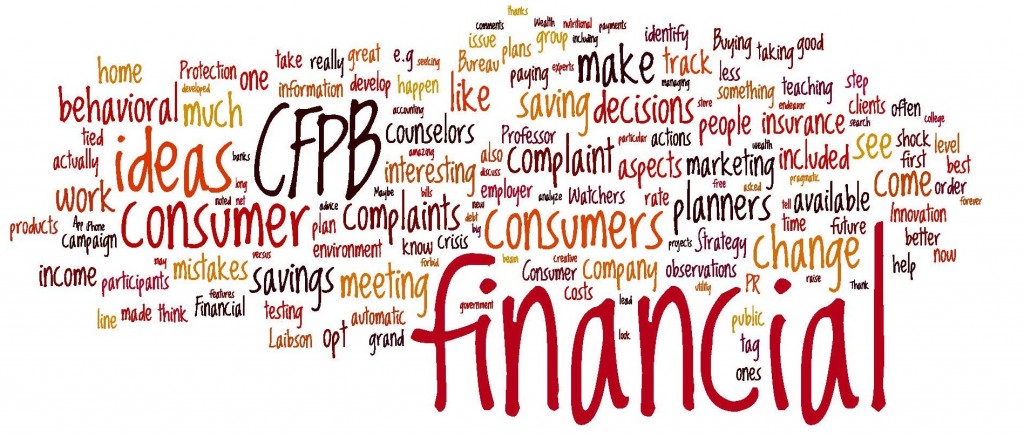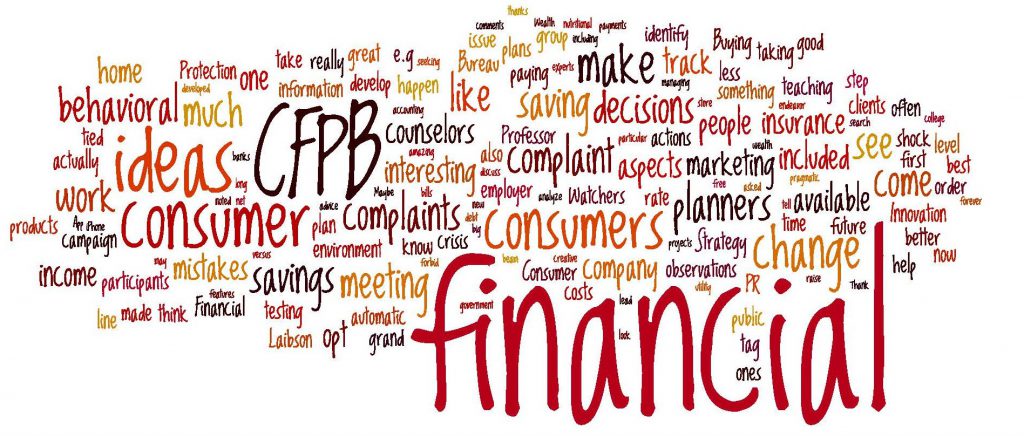Elissa’s Report from the Consumer Financial Protection Bureau Innovation Strategy Meeting

Elissa participated in the Consumer Financial Protection Bureau’s first Innovation Strategy meeting, held on Tuesday and Wednesday in Washington, D.C. This is her report on the proceedings. Thanks to all of you who shared your ideas and comments!
Elissa’s Report
The purpose of the CFPB Innovation Strategy Meeting was to identify common financial mistakes made by consumers, to analyze behavioral aspects that lead to these mistakes and to develop creative ideas to help consumers make better financial decisions. There were 32 participants in addition to Consumer Financial Protection Bureau (CFPB) staff. The participants included behavioral experts (consultants and academics) and financial counselors (ranging from credit and home foreclosure counselors to financial planners dealing with high net worth clients).
I have two initial “big picture” observations that are actually appreciations. First, having a government agency include “real” financial planners (CFP licensees) in a brainstorming meeting like this is a great step. While financial counselors (who often deal with lower-income clients and those in crisis) have long been valuable contributors to these gatherings, it is less often that professional financial planners have been included. I was heartened to be included (and, interestingly, to know each of the other financial planners at the gathering). Second, I was thrilled to see this entire endeavor focused squarely on the behavioral aspects of consumer financial decisions. So much consumer financial policy seems to be predicated upon economic concepts (e.g. maximizing expected utility) without consideration for values, cultural and social norms and other interior aspects and motivations.
What was interesting (and frustrating for me, because I had grand plans for this group to develop a consumer saving and investing tag line much like the nutritional tag line, “Strive for Five,” or Nike’s, “Just Do It.” “Live Big” may be taken, but I was certain we could come up with something almost as good.) was the laser beam focus required of us to come up with actual actions that consumers are taking and what actions we want them to take and how we can intervene with them to make this happen. I can’t say the resulting solutions were all as action-oriented as I think was hoped for. But we did manage to stay away from marketing and PR campaign ideas (darn it). This is not to say that the CFPB is not going to ultimately do research, have PR and marketing campaigns or establish long-range projects. But for now, the Bureau wants to take some pragmatic step(s) forward, including conceptualizing grand ideas and testing them in controlled environments (for example, testing “opt out” 401(k)s with automatic acceleration by finding a large employer who would be willing to offer these features to some of their employees to see what the effect on savings was).
So here, in no particular order, are some observations and sharings from the meeting.
- Maybe my favorite quote, from Harvard Professor, David Laibson, “Saying that financial education doesn’t work is like teaching someone to swim and then throwing them into a shark tank and saying teaching swimming doesn’t work.”
- An observation about saving: “There is not enough emotion tied to saving (like there is tied to spending or consuming).”
- Change is difficult to make happen (I knew this … we all know this … but it is interesting to discuss it in the context of bad financial decisions). More information doesn’t help (heaven forbid we get more information than we already have on financial products and decisions). More value doesn’t even, necessarily, work. It is much easier to commit to change in the future than to change now … and this behavioral issue can be harnessed. Real change can be brought about best by helping consumers envision themselves in that better place in the future.
- The CFPB has a consumer complaints process that actually addresses the complaints against banks and pay-day lenders. CFPB accepts complaints from the public, passes the complaint on to the company in question, and pursues resolution if the company does not address the complaint to the consumer’s satisfaction. CFPB also tracks these complaints at a macro level in order to see trends and to identify areas of concern.
- The complaint database is available at the CFPB website: https://www.consumerfinance.gov/complaintdatabase/
- Complaints can be made at: https://www.consumerfinance.gov/complaint/
- There is also a “Tell Your Story” feature available through the CFPB where people can tell stories of success and problems (where filing a formal complaint is not of interest to the consumer).
- Most consumers are not prepared for any financial shock of any magnitude (they have no reserves).
- Pay-day lending can be a serious problem for consumers … and for some is the only way they are able to feed their families at the end of a month, particularly if some “financial shock” comes along. Finding another solution for them would be really beneficial.
- Here were the 10 consumer mistakes that got the most attention from the group:
- – – Not having a plan for paying bills and paying the most pressing ones (e.g. the ones where they are getting phone calls).
- – – Not seeking investment/retirement advice.
- – – Having no developed pattern of saving.
- – – My thoughts on this: Solving this one issue would change everything.
- – – The challenges of students choosing the best college financing alternatives.
- – – Buying a home one can not afford; Buying a home and not accounting for associated costs (such as taxes, insurance, repairs, etc.).
- – – Not understanding the duty of care (whose interests come first) of different types of financial advisors.
- – – Not organizing and managing financial details and decision-making.
- – – Not accessing benefits (public or employer).
- – – Not securing appropriate financial products for stage of life and/or income/asset level.
- – – Scam prevention.
- A study (noted by Professor Laibson) found that if you ask lower income individuals if they have any cash flow slack, they say no. But if they are subject to an automatic enrollment to save 6% of their income, few opt out and those who do not opt out, when asked a year later, have not missed the money.
- Three ideas that (not new ideas from this meeting, but maybe the CFPB can do something with them) could really change things, in my opinion:
- – – Provide 401(k) plans for all (only 50% of US workers have access to a 401(k) plan).
- – – Make 401(k) participation an opt-out environment, versus an opt-in environment.
- – – Establish auto-escalation provisions (whereby an employee is auto-enrolled at some savings rate, let’s say 5%, and then, potentially at each pay raise, increase that savings rate, let’s say by 1%).
- Very interesting company I learned about: Wealth Watchers International. This is a savings program fashioned after the Weight Watchers methodology. After some work on budgeting, you come up with how much you can spend each day, and then you track it. You can track it in little booklets that you carry with you, or you can track it on the app (just search “wealth watchers” in the App store – only available for iPhone currently, and free for a limited time).
There was a lot that wasn’t covered that I would have liked to see. Here is one such area. This is not simple for people to achieve (and there truly are people for whom this is an impossibility, and other ideas are needed for them) … but if acknowledged as aspirational, I think we could make some progress with a marketing campaign that encouraged the following (which, I believe, if followed, would eliminate most consumer financial crisis):
- Save 10% of every dollar you earn forever.
- Secure catastrophic health insurance and disability insurance.
- Keep your debt payments and housing costs to less than 1/3 of your income.
Much thanks to everyone who sent me such amazing input. You enabled me to show up with so many great ideas to share. Thank you for taking the time to make me look good! 🙂

